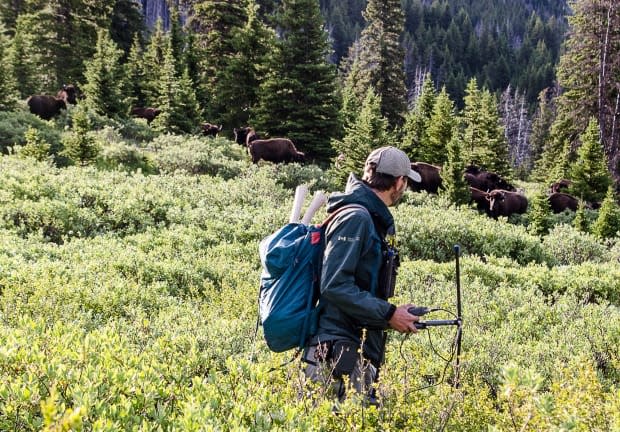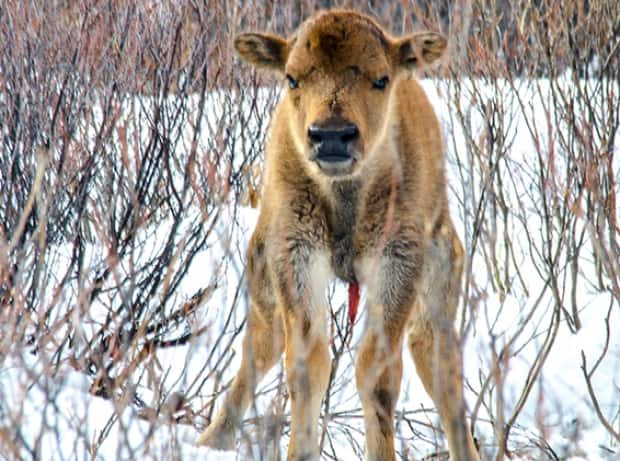What does it take to reintroduce and contain a herd of bison to a national park?
What does it take to introduce, and then maintain, a herd of bison in a national park?
Years of planning, meticulous tracking — and a really cool fence.
With one year left in the Banff Bison Reintroduction Project, facilitators say it has been going well.
"Bison are really iconic animals," Karsten Heuer, the project manager, told CBC. "I mean, they symbolize the wild, free, North American idea of what this continent used to be, and I think bringing them back after an absence of over 140 years is an incredibly powerful notion of restoration, and reconciliation, and rejuvenation for people."
The bison were brought from Elk Island National Park, just east of Edmonton. There were 16 animals to start, including 10 pregnant females. They were originally held in a fenced habitat.
"They've been free for over two years now. And their health is … a really good measure of it is how well they're reproducing," Heuer told the Calgary Eyeopener. "We've had about a 38 per cent growth rate in the herd every year. And that's led us to have 50 animals, as compared to the 16 we brought in just over three years ago."
Up to 20 calves are expected this year, and Heuer says he wouldn't be surprised if the herd grows from 50 to 75 in 2021.
Heuer says they have lost two calves, one to unknown causes and the other to wolves.
"In a way, it is a little bit of a measure of our success, because, as you know, we're trying to not just restore bison to the landscape, but their ecological role and the actual integrity of the ecosystem."
Heuer says bringing plains bison into a mountain landscape was a bit of an unknown.
"As soon as we released them, they went up onto the ridge tops, started using avalanche slopes ... where the vegetation is quite productive and really kind of succulent and palatable in those summer months," Heuer said.
"We thought that was maybe a bit of an anomaly as they were searching around their new home range. But that's a pattern that's played out over the last three summers pretty consistently, that they did go up high and use the full extent of the mountain habitat that's available to them during the course of the year."
Heuer says there's early evidence that the herd is having a positive impact on the landscape and ecosystem in the area. The clumps of fur that they cast off are proving popular in many bird nests, and the grass seems to grow back just a little more lush in the meadows where they have grazed.

"I wasn't sure, to be perfectly honest, how well they would fit into the landscape. But the first time I kind of came around the corner and saw them feeding in a shrub meadow and their backs in, you know, beautiful sort of reddish brown colour in the light, it was — it just totally seemed like it fit, like it was, it was made to happen here," he said.
The area that has been earmarked as the initial reintroduction zone is 1,200 square kilometres, which provides plenty of room to roam for what Heuer says is a relatively small number of bison.
It is one of only five bison populations in North America that will be subject to all the natural selection pressures, including exposure to wolves and grizzly bears.
"You know, they're exposed to all the climatic extremes that the world is going to throw at them. We haven't fed them anything since we released them from the pasture in the backcountry over two years ago," Heuer said. "And they've been thriving."
For those who will be born in the mountains, the habitat seems like a natural fit.
Listen to the full interview on the bison herd here:
"The calves are pretty incredible. They're born very, very ready to go, they're up and standing and running within hours," he said.
"They have these beautiful, big, liquid black eyes. They're robust, they're tough, they're playful … it's hard not to chuckle as you see them, you know, butting heads and going up to the biggest bulls and trying to provoke playful responses."
One of the biggest challenges was how to contain the herd within the safety of the national park.
That's where the "bison fence" came into the picture.
When the 16 wild bison were reintroduced to the park, it was the first time bison had been there in nearly 150 years. And the current fences would not contain them.
That meant the team had to design a fence that would allow the free passage of other wildlife, while containing the bison.
"The riddle we were faced with was that these fences are an important tool in keeping the reintroduced bison inside the park," Dillon Watt, team member and a co-author of the research paper, told The Homestretch.
"But as you zoom out and think about the overall objective of preserving and maintaining biodiversity and the natural processes of the ecosystem, it becomes clear that you need these fences to not have a negative impact on the other wildlife that share the park."
The team spent more than three years using remote cameras and GPS collars on wildlife to narrow it down.
"It required a lot of adaptability on our part," Watt said.
The result was a series of short fences that were placed in strategic areas.
"These short fences, we placed them in natural topographic pinch points, and they're a lot like fences that you … would probably expect to see, wire and rail fences," Watt said. "But the interesting part for us was how to configure these rails and wires in number and spacing to accommodate different ways for other species to get through."

The bison reintroduction team recently published their research in the online academic journal Wildlife Biology.
"They're working well, the fences have largely been successful in containing the bison, and our research showed that all the species can navigate the fences — and on top of that, the fences do not have an effect on larger scale movements and migration," Watt said.
Watt says the research will likely prove useful to other projects.
"That's where our contribution can be important, I think, beyond just what our team has done here. We know now globally that species reintroductions are such an important tool in restoring ecosystems.… The world being the way it is now, these large, intact, big wild places are harder and harder to come by," Watt said.
"And so as our species are reintroduced, it's increasingly common that they have to be kept in these discrete areas. So using tools like the fence is super important."
There is one year left in the project. Facilitators hope to answer the question of whether it is feasible to continue to restore bison to the landscape when the pilot phase of the Banff Bison Reintroduction Project wraps up in 2022.
With files fromThe Homestretch and the Calgary Eyeopener.

